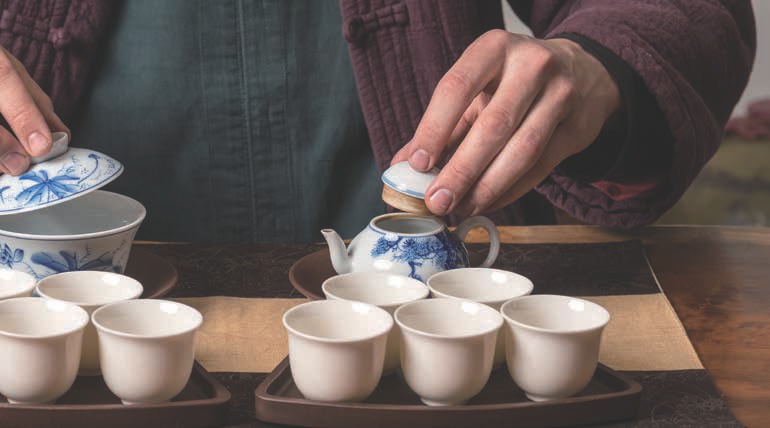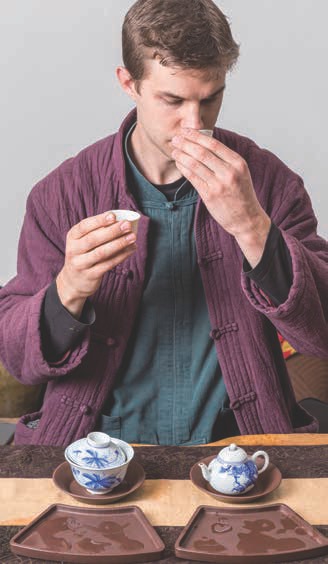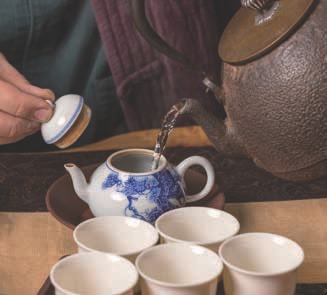
 |
|

Month in and month out we publish these gongfu experiments for you to try at home. Before we dive into the May experiment, I thought it would be appropriate to tip our hat in the direction from which knowledge always flows: above.
Wu De often gives the example that with a book and a teacher, everyone can learn algebra within two years. If you take away the teacher, maybe only 20% of people can learn quadratic equations. Without the book or the teacher, no one learns algebra! Knowledge is accumulated. This means it is passed down, absorbed, understood, applied and then refined, generation after generation. As knowledge is given to us, it comes through the lives, experience and spirit of all those who carried it before us. Lifetime after lifetime, master after master, these teachings flow down to us. The wisdom becomes sharpened through the hands of those who hold it correctly, like a knife on a sharpening stone - one turning century-slow. Knowledge, like the blade, can also be dulled if those wielding it do not care for it. (But that is a topic for another day.) The fundamental point made here is that teachings are greater than any individual. They are the collected insights of all those who have passed them down to us. This is what we are bowing to in the learning process, the wisdom flowing through the teacher, not the teacher herself!
But for this formula to work, there must be one to teach and one to be taught, one above and one below. Our Western minds often struggle with this idea, without fully understanding it. We believe that we are giving something away through surrender when in fact the truth is at the other end of the spectrum: we are receiving. As the Dao De Ching says, "All streams flow to the sea because it is lower than they are." In other words, the ocean does not decrease because it embraces the rivers. Instead, this is the reason it is so vast. The sea's humility is the source of its power. In Zen the concept of Shoshin, or "Beginner's Mind," is the goal of practice. Such a mind is open to possibilities, eager and lacks all ego and pretension. Even as we develop some mastery, we should always maintain a practice of beginner's mind. In other words, it is the teacher's job to teach and the student's responsibility to learn. If we cannot put ourselves below, then we demonstrate a lack of understanding that means we are not ready to be above. We are stuck in the perception that it is about who is higher and lower and have not seen what is really important: the flow of wisdom that reaches beyond any one of our individual lives.
The teacher's role is to inform, clarify and correct. The Eightfold Path always begins with Right View. Right View means understanding things as they are. It is an essential starting point, without which we can head off down the wrong path or take a detour. Teachers ensure we continue to cultivate Right View in whatever they teach and to correct us as we learn. They too have placed themselves below another, applied themselves and seen the benefit. The teacher is offering you the opportunity to have the same experience. Their job is to create the conditions for wisdom to arise: what you do with the situation is up to you. These experiments, month in and out, offer you this chance. They are opportunities to develop your tea wisdom. They are invitations to growth.

Now for this month's experiment! This time we looked at the influence of the brewing vessel's shape on the final cup. There seems to be no shortage of options when it comes to choosing a vessel; each one will obviously impact the tea. We need to be able to test and understand the differences between these to develop our gongfu. Initially, a teacher can help design these experiments and tell us about signposts to look for along the way. In the end, we have to be able to create our own investigations to evaluate tea and teaware. Some of the experiments, like this month's, you may not be able to do at home because you do not have the teaware. Do not worry, though! Merely adjust the procedure to your teaware.
Here in the Center we are fortunate to have the opportunity to compare the effects of the shape of the brewing vessel directly. We have a gaiwan and teapot that were made from the same material (porcelain) and fired in the same kiln on the same day! This means we can assess the influence of shape and remove much of the question of material.
You will need two vessels to compare. We used the gaiwan and teapot mentioned above. Identical cups are best if you have them. We use the same white porcelain ones every month. You will need two of these. We always use a lightly oxidized oolong, brewed weakly, so the flavors do not distract us from mouth sensations. And that is it. No need to make things too complicated!
Heat your kettle until it is just below a full boil. Place two or three grams of tea in each vessel, then rinse the leaf. You will want to be able to pour the vessels at the same time, with one in each hand. I had the gaiwan in my right and teapot in my left for practical reasons. (You should try switching hands if you feel confident doing so, as this also influences the final brew.) Do not warm the cups, but pour straight into each from the respective vessel, as warming adds another dimension and we want to isolate the influence of shape by itself. Try to get the same amount of water in both vessels. I counted as I poured from the kettles as a way of measuring. Then pour into both cups from the respective vessels at the same time. Taste back and forth between the cups. We started with the gaiwan, looking for the differences in mouth sensations mentioned in the March issue.



